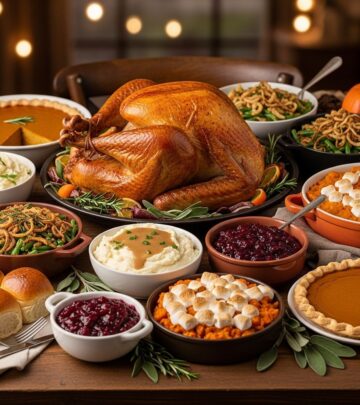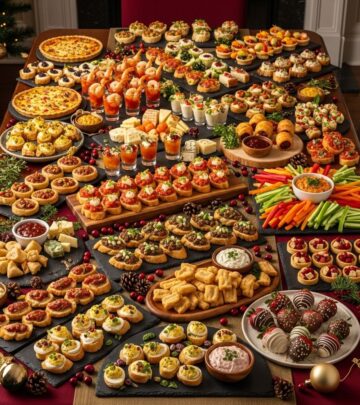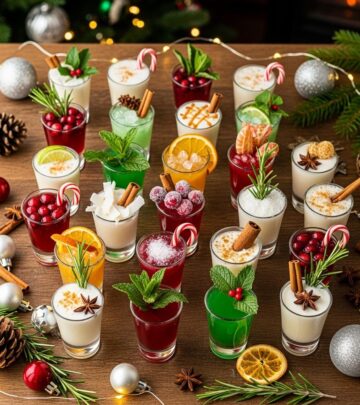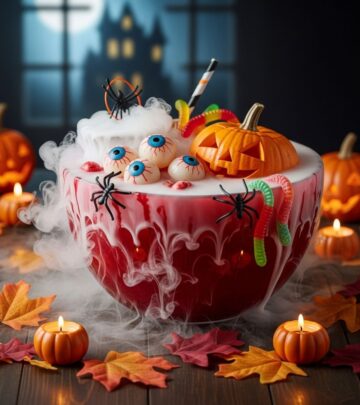Thanksgiving Turkey Recipe: Expert Guide To Juicy, Crispy Skin
Create the perfect centerpiece for your holiday table with this incredibly moist and flavorful turkey recipe
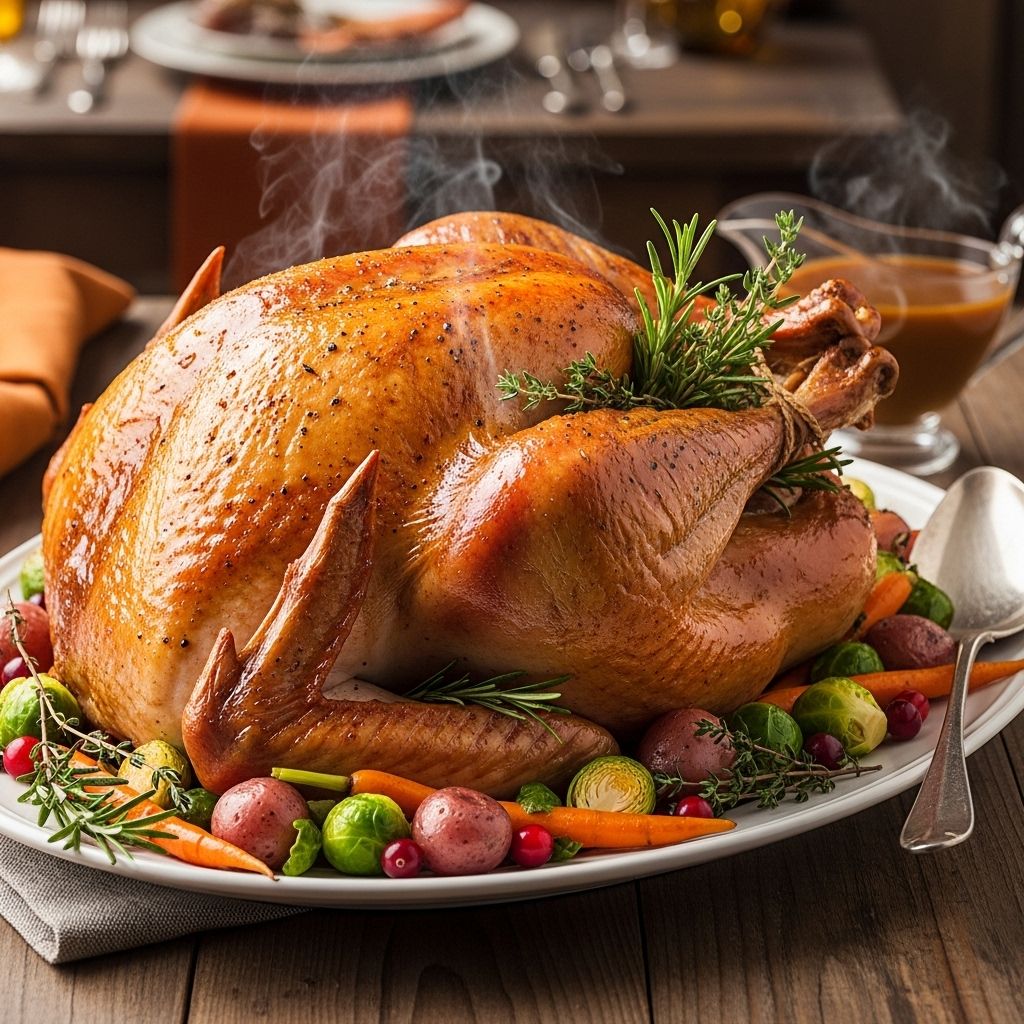
Image: HearthJunction Design Team
The Secret to a Perfectly Juicy Thanksgiving Turkey
Thanksgiving dinner revolves around one spectacular centerpiece: the turkey. Yet so many home cooks struggle with dry, flavorless birds that disappoint after hours of preparation. This recipe solves that common problem by incorporating a few key techniques and ingredients that ensure a remarkably juicy, flavorful turkey your guests will rave about for years to come.
The secret? A combination of champagne, citrus, and aromatics that work together to create a turkey that’s moist on the inside with beautifully crisp, golden skin. Unlike traditional methods that often result in dry meat, this approach uses champagne and broth to infuse moisture and flavor throughout the cooking process.
Whether you’re a first-time turkey roaster or a seasoned Thanksgiving host looking to elevate your game, this recipe delivers consistently excellent results that will make your holiday meal truly memorable.
Ingredients for Your Juicy Thanksgiving Turkey
The foundation of this spectacular turkey recipe lies in its carefully selected ingredients that work in harmony to create deep flavor and maintain moisture throughout the roasting process. Here’s everything you’ll need:
- 1 (12 pound) whole turkey
- 2 tablespoons dried parsley
- 2 tablespoons ground dried rosemary
- 2 tablespoons dried sage
- 2 tablespoons dried thyme
- 1 tablespoon lemon pepper
- 1 tablespoon salt
- 2 stalks celery, chopped
- 1 orange, cut into wedges
- 1 onion, chopped
- 1 carrot, chopped
- 1 (14.5 ounce) can chicken broth
- 1 (750 milliliter) bottle champagne
The combination of dried herbs creates a fragrant rub that seasons the turkey perfectly, while the aromatics (celery, orange, onion, and carrot) stuffed inside the cavity infuse the meat with subtle flavor from within. The champagne and broth mixture is the real game-changer, keeping the turkey exceptionally moist as it roasts.
Essential Equipment and Preparation
Before diving into the cooking process, gather the following equipment to ensure smooth preparation:
- Large roasting pan
- Aluminum foil
- Kitchen string
- Meat thermometer
- Small mixing bowl (for herb mixture)
- Basting brush or spoon
- Kitchen shears (optional, for trussing)
- Carving knife and fork
Proper preparation is key to success with this recipe. Start by ensuring your turkey is fully thawed if purchased frozen. A 12-pound turkey typically needs 3 days to thaw safely in the refrigerator. Remove the turkey from refrigeration about 30-45 minutes before cooking to take the chill off, which helps it cook more evenly.
Step-by-Step Cooking Instructions
Preparing the Turkey
Begin by preheating your oven to 350 degrees F (175 degrees C). This moderate temperature allows the turkey to cook slowly and evenly, preventing the exterior from burning while ensuring the interior cooks thoroughly.
Remove the turkey’s giblets and neck from the cavity. Rinse the turkey inside and out under cold running water, then pat dry thoroughly with paper towels. A dry surface is essential for the herbs to adhere properly and for achieving crispy skin.
In a small bowl, combine the dried parsley, rosemary, sage, thyme, lemon pepper, and salt, mixing well to create a uniform herb blend. This aromatic mixture will serve as a flavorful rub for the turkey, infusing it with classic holiday flavors.
Place the turkey in a large roasting pan. Gently loosen the skin from the breast meat with your fingers, being careful not to tear it. Rub the herb mixture under the skin and over the outside of the turkey, covering it completely for maximum flavor penetration.
Stuffing and Trussing
Stuff the turkey cavity with orange wedges, chopped celery, onion, and carrot. Unlike traditional bread stuffing, these aromatics are not meant to be eaten but rather to impart moisture and subtle flavor to the meat from the inside as the turkey cooks.
After stuffing the cavity with aromatics, tie the legs together with kitchen string to help the turkey maintain its shape while cooking. This process, known as trussing, promotes even cooking by keeping the legs close to the body. Next, tuck the wing tips under the body of the turkey, which prevents them from burning and creates a more aesthetically pleasing presentation.
Preparing the Roasting Pan
Line a large roasting pan with sheets of aluminum foil that extend beyond the pan’s edges. This foil will eventually be wrapped around the turkey to create a sealed cooking environment that locks in moisture.
Place the prepared turkey on the foil in the roasting pan. Pour the chicken broth and champagne over the turkey, ensuring some of the liquid pools at the bottom of the pan. This liquid bath is crucial—it will create steam during cooking and continuously baste the turkey from below.
Bring the aluminum foil up and over the turkey, sealing it well but keeping the foil from touching the skin of the turkey. This creates a tent that allows the turkey to steam in the champagne-broth mixture while still allowing space for hot air to circulate.
Roasting Process
Place the roasting pan with the foil-tented turkey in the preheated oven. Roast for 2 1/2 to 3 hours, or until the internal temperature of the thickest part of the thigh reaches 180 degrees F (82 degrees C) and the juices run clear when pierced with a fork.
For the final 30 minutes of cooking, carefully open the foil tent to allow the turkey skin to brown and crisp. Keep a close eye on it during this stage to prevent over-browning.
Once the turkey has reached the proper temperature, remove it from the oven and let it rest, loosely covered with foil, for 15-20 minutes before carving. This resting period is crucial as it allows the juices to redistribute throughout the meat, resulting in moister slices when carved.
Serving Suggestions and Pairings
This juicy Thanksgiving turkey pairs beautifully with all the traditional holiday sides. Consider serving it with:
- Creamy mashed potatoes with turkey gravy
- Classic bread stuffing or dressing
- Cranberry sauce (both jellied and whole berry for variety)
- Green bean casserole with crispy fried onions
- Sweet potato casserole with marshmallow topping
- Buttery dinner rolls
- Roasted Brussels sprouts with bacon
For wine pairings, consider serving a medium-bodied Pinot Noir which complements the turkey without overwhelming it. If you prefer white wine, a lightly oaked Chardonnay or Viognier works beautifully with the herb flavors in this recipe.
Make-Ahead Tips and Storage Information
While the turkey itself is best prepared and cooked on Thanksgiving Day, several elements can be prepared ahead of time to streamline the process:
- Mix the dried herb rub up to 3 days in advance and store in an airtight container
- Chop the celery, onion, and carrot the day before and refrigerate in separate containers
- Prepare the roasting pan with foil the night before
If you have leftover turkey, properly store it to enjoy in the days following Thanksgiving:
Refrigerate leftover turkey within two hours of cooking. Remove the meat from the bones and store in shallow, airtight containers. Properly stored turkey will last 3-4 days in the refrigerator. For longer storage, freeze leftover turkey in freezer-safe containers or heavy-duty freezer bags for up to 3 months.
Troubleshooting Common Turkey Problems
Even with a foolproof recipe, turkey roasting can sometimes present challenges. Here are solutions to common problems:
Turkey Cooking Too Quickly
If you notice the turkey browning too fast, secure an additional piece of foil loosely over the top. This will slow down the browning while allowing the turkey to continue cooking.
Undercooked Turkey
If your turkey reaches the recommended cooking time but hasn’t reached the proper internal temperature, continue cooking in 15-minute increments, checking the temperature after each interval.
Dry Turkey Meat
While this recipe specifically addresses the common problem of dry turkey, if you find parts of your turkey (particularly the breast) becoming dry, try placing a cheesecloth soaked in butter over the breast area during cooking.
Nutritional Information and Dietary Considerations
This juicy Thanksgiving turkey recipe yields approximately 12 servings. Each serving (approximately 6 ounces of turkey meat without skin) contains about:
- Calories: 285
- Protein: 48g
- Fat: 8g
- Carbohydrates: 1g
- Sodium: 390mg
For those with dietary restrictions, note that this recipe is naturally gluten-free. However, always check the labels of your chicken broth and champagne to ensure they meet your dietary requirements.
Frequently Asked Questions (FAQs)
Q: Can I use a different type of alcohol instead of champagne?
A: Yes, you can substitute the champagne with white wine, prosecco, or even apple cider for a non-alcoholic option. Each will impart a slightly different flavor profile to the turkey.
Q: Do I need to brine this turkey before cooking?
A: No, brining is not necessary for this recipe. The champagne and broth mixture, along with the aromatics, provide ample moisture and flavor without the extra brining step.
Q: How long should I thaw my turkey before cooking?
A: Allow approximately 24 hours of thawing time in the refrigerator for every 4-5 pounds of turkey. For a 12-pound turkey, that’s about 3 days of thawing time.
Q: Can I stuff this turkey with traditional bread stuffing?
A: While you could replace the aromatics with bread stuffing, it’s not recommended for this recipe. The aromatics are crucial for flavor infusion, and cooking stuffing inside the bird can lead to food safety concerns and longer cooking times.
Q: How do I know when my turkey is done cooking?
A: The most reliable method is using a meat thermometer. The turkey is done when the internal temperature at the thickest part of the thigh reaches 180°F (82°C) and the breast reaches 170°F (77°C).
This Juicy Thanksgiving Turkey recipe has been a holiday favorite for many families, providing a reliable method for creating a memorable centerpiece that avoids the common pitfall of dry, flavorless meat. By using the combination of aromatic herbs, citrus, vegetables, and the unique champagne basting liquid, you’ll create a turkey that’s guaranteed to impress your holiday guests and become a cherished tradition for years to come.
References
- https://www.allrecipes.com/recipe/166160/juicy-thanksgiving-turkey/
- https://www.allrecipes.com/gallery/best-thanksgiving-turkey-recipes/
- https://www.allrecipes.com/recipe/43655/perfect-turkey/
- https://www.allrecipes.com/recipe/13464/homestyle-turkey-the-michigander-way/
- https://www.youtube.com/watch?v=i7Ilhhma69M
Read full bio of Anjali Sayee







